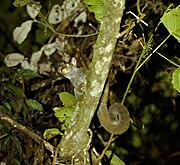
Galagos, also known as bush babies or nagapies, are small nocturnal primates native to continental, sub-Sahara Africa, and make up the family Galagidae. They are considered a sister group of the Lorisidae.

The Senegal bushbaby, also known as the Senegal galago, the lesser galago or the lesser bush baby, is a small, nocturnal primate, a member of the galago family Galagidae.

Lesser bushbabies, or lesser galagos, are strepsirrhine primates of the genus Galago. They are classified, along with the other bushbaby and galago genera in the family Galagidae. They are probably the most numerous primate in Africa, and can be found in every large forest on the continent, inhabiting forested areas, savannas, riverine bush and open woodlands.

The greater galagos or thick-tailed bushbabies are three species of strepsirrhine primates. They are classified in the genus Otolemur in the family Galagidae.

The pottos are three species of strepsirrhine primate in the genus Perodicticus of the family Lorisidae. In some English-speaking parts of Africa, they are called "softly-softlys".

The Zanzibar bushbaby, Matundu dwarf galago, Udzungwa bushbaby, or Zanzibar galago is a primate of the family Galagidae. An adult typically weighs 150 grams (5.3 oz), its head-body length is 14 to 15 centimetres and its tail is between 12 and 15 centimetres long. Like other species of galagos, its diet consists mainly of fruit, insects, and tree gums.

Red colobuses are Old World monkeys of the genus Piliocolobus. It was formerly considered a subgenus within the genus Procolobus, which is now restricted to the olive colobus. They are closely related to the black-and-white colobus monkeys, and some species are often found in groups with the blue monkey. The western red colobus is frequently hunted by the common chimpanzee.

The southern needle-clawed bushbaby is a species of strepsirrhine primate in the family Galagidae. Found in Cameroon, Central African Republic, Republic of the Congo, and possibly Democratic Republic of the Congo, its natural habitat is tropical moist forests. While the species is not threatened or endangered, some local populations may be threatened by habitat destruction.

The northern needle-clawed bushbaby is a species of strepsirrhine primate in the family Galagidae. It is found in the coastal region of Cameroon and Nigeria, and on the island of Bioko, Equatorial Guinea in lower-elevation forests that provide its specialized diet of tree gum and resins.

Bioko Allen's bushbaby, also known as the Bioko squirrel galago, is a species of primate in the galago family found in Cameroon, Nigeria, and the island of Bioko, Equatorial Guinea. Its natural habitat is subtropical or tropical dry forests. The bushbaby is currently near-threatened, according to the International Union for Conservation of Nature.

The Somali bushbaby, or the Somali lesser galago, as it is also known, is a species of nocturnal, arboreal primate in the family Galagidae. It is found in Ethiopia, Kenya, and Somalia. It is threatened by habitat loss.

Grant's bushbaby, also known as Grant's lesser bushbaby or the Mozambique lesser bushbaby, is a species of primate in the family Galagidae. It is found in Malawi, Mozambique, Tanzania, and Zimbabwe. Its natural habitat is subtropical or tropical dry forests. It is a common species and the International Union for Conservation of Nature has assessed its conservation status as being of "least concern".

The dusky bushbaby is a species of primate in the family Galagidae. It is also known as Matschie's galago, in honour of the German zoologist Paul Matschie, curator of mammals at the Museum für Naturkunde in Berlin. Native to tropical Central Africa, it is found in forests in Burundi, Rwanda, Democratic Republic of the Congo and Uganda. The species is small with a long tail, and has an arboreal, nocturnal and omnivorous lifestyle.

The Mohol bushbaby is a species of primate in the family Galagidae which is native to mesic woodlands of southern Africa. It is physically very similar to the Senegal bushbaby, and was formerly considered to be its southern variety. The two species differ markedly in their biology however, and no hybrids have been recorded in captivity.

The Rondo dwarf galago or Rondo bushbaby is a species of primate in the family Galagidae. The dwarf galagos are the smallest members of the genus Galagoides. It weighs less than 100 grams, making it the smallest known galago. It is endemic to Tanzania where its natural habitat is subtropical or tropical dry forests. It lives in an area reported in 2012 to be less than 100 square kilometers and is threatened by habitat loss due to logging. While it was discovered in the 1950s, the Rondo dwarf galago was deemed data deficient until 1996. In 1996, the Rondo dwarf galago was fully described as a species. It is now listed as one of "The World's 25 Most Endangered Primates."

Thomas's bushbaby is a species of primate in the family Galagidae. It is found in Angola, Burundi, Cameroon, Democratic Republic of the Congo, Equatorial Guinea, Gabon, Kenya, Nigeria, Rwanda, Tanzania, Uganda, and Zambia.

The Gabon bushbaby is a species of primate in the family Galagidae found in Cameroon, Gabon, and the Republic of the Congo. Its head and body length is 8.5 in with a 10-in tail, and it weighs about 10 oz. It lives in evergreen tropical rainforests and eats primarily fallen fruit, but also some arthropods.

The squirrel galagos are a group of four species of strepsirrhine primates. They are classified in the genus Sciurocheirus of the family Galagidae.

The eastern dwarf galagos are a group of five species of strepsirrhine primates of the family Galagidae, native to East Africa. They were formerly classified in the genus Galagoides but have been moved to their own genus, Paragalago, based on genetic evidence, and supported by differences in vocalizations and morphology. The three western/Congolian species remain in Galagoides.























